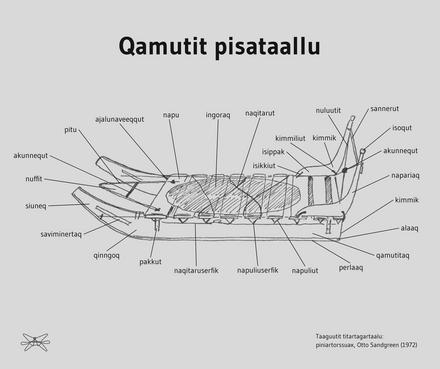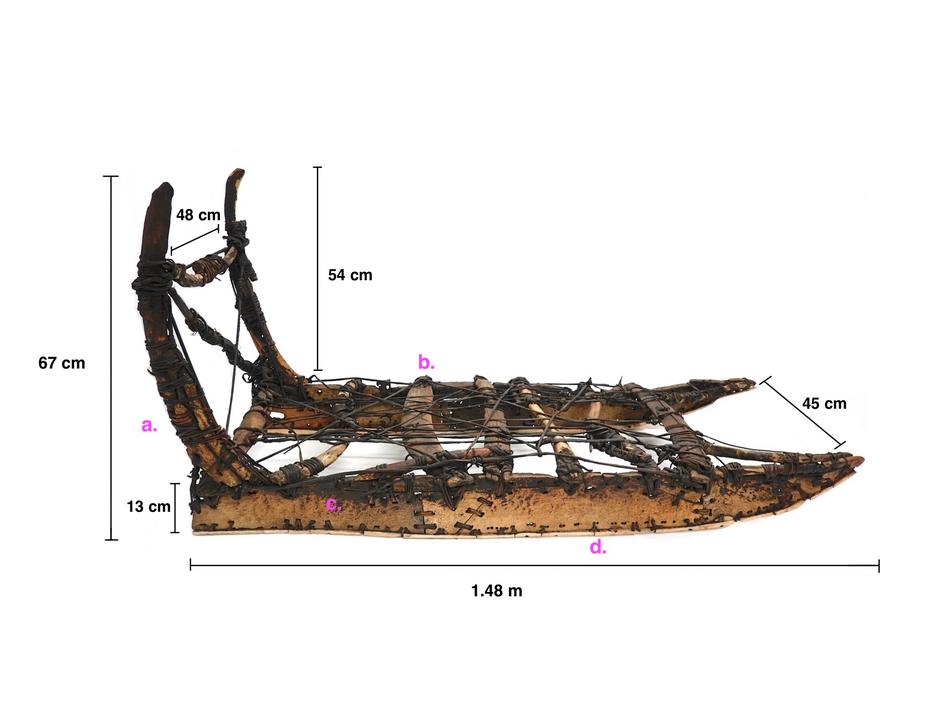
Terms in Greenlandic
Here, you can learn about the different parts of a dog sled and dog harness in Inuktitut/Greenlandic.
The Dog Sled
The design of dog sleds expertly balances tradition, available materials, local terrain, and climate, leading to distinct regional variations. Dog sleds have been central to Inuit culture for centuries, playing a vital role in mobility, transport, and cultural diffusion since the 13th century. The sled is not a static tool but a flexible technology continuously adjusted, rebuilt, and repaired based on need and function. Archaeological evidence, such as dog sled toys and models, indicates that Inuit have used this technology for over 800 years. The oldest known sled parts and dog bones, approximately 9,000 years old, were found in Siberia, suggesting that dog sled technology originated there and spread eastward across the Arctic.
Sled design also depends on its intended use (short or long trips, transport or hunting):
- North Greenland: Sleds are often long and narrow, ideal for transport over sea ice.
- West Greenland: Sleds are typically shorter and wider, often with uprights to suit steep and uneven terrain.
- South Greenland: Dog sleds were very rare due to a warmer climate and consequently sparse ice and snow.
- East Greenland: Sleds are generally smaller, as larger snow amounts and shorter travel routes necessitated different constructions.
Construction Materials
Beyond climate and geography, access to construction materials significantly influenced sled design. Traditionally, driftwood was used for sleds, kayaks, skin boats, and tools until the 17th-18th centuries. Increased contact with the outside world provided Inuit with access to new materials, which over time influenced sled construction. Today, sleds are typically built from specific wood types, held together by cords without nails, except for beading. Economic prosperity and the development of trading posts between the 1880s and 1920s led to a significant increase in sled numbers and the introduction of new construction materials.
However, sled culture faces new challenges in a rapidly changing social and climatic environment in the North. Technological advancements and the proliferation of snowmobiles threaten traditional sledding and the generational knowledge associated with the craft and use of dog teams.

Sled from 1818
The oldest intact dog sled from Greenland is preserved at the British Museum in London. Dating back to 1818, it was brought to England by British expedition leader John Ross, who sought a sea route through the Northwest Passage. Ross purchased the sled on August 13, 1818, from an Inughuaq (Polar Inuit) named Maigack, during his expedition through northern Greenland. This sled is a unique example of traditional Inuit craftsmanship, comprising 89 individual component parts made entirely from animal materials such as whale, walrus, reindeer, and seal.
Archaeologist and PhD student Emma Vitale, associated with the Qimmit project, has examined this sled at the British Museum. Her research focuses on Inuit dog sled technology and the interplay between knowledge, practice, and materials in sled construction. Vitale employs experimental methods and ethno-archaeological observations, contributing new insights into ancient carpentry techniques, building processes, and cultural knowledge.
Read Vitale's articles here.